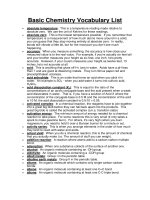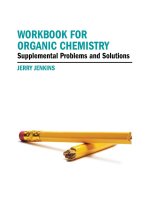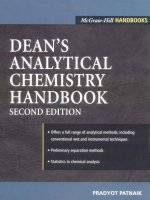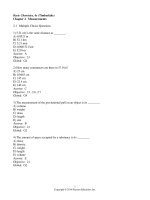Basic chemistry book first edition
Bạn đang xem bản rút gọn của tài liệu. Xem và tải ngay bản đầy đủ của tài liệu tại đây (1.67 MB, 133 trang )
I
Basic Chemistry Book
|
By Mr. Mohamed Hersi Farah
Published by: Lulu Press, Inc.
627 Davis Drive, Suite 300, Morrisville, NC 27560, United States
Call: +18442120689
Published: October 26, 2019
ISBN: 978-1-79470-410-7
Content ID: 25451672
Product ID: 24295681
Mr. Mohamed Hersi Farah
International University of Africa Sudan Khartoum
B.Sc. Chemistry
University of Medical Science and Technology Sudan Khartoum
M.Sc. Pharmaceutical Chemistry
E-mail:
Phone: +249901817294
I
Basic Chemistry Book
|
By Mr. Mohamed Hersi Farah
Preface
This edition of basic chemistry book, were based on
Puntland secondary syllabus in high school education.
This textbook has been designed to help you in your study
of chemistry in Puntland state of Somalia.
II
Basic Chemistry Book
|
By Mr. Mohamed Hersi Farah
Acknowledgements
I would like to thank my best friends Dr. Alsheikh
Mohamed
Farah,
Mr.
Barbara,
Hamza
Mr.
Shuiab
Mubarak, Mr. Alshiekh Ismail Hassan Abdullahi, Mr.
Mohamed
Abdulkadir
Diriye
and
Abdulahi
for
never
ending
encouragement
their
throughout
the
Mr.
Mona
Omar
patience
production
of
and
this
textbook.
And also, I would like to acknowledge everyone who
played a role for the completion of this book. I would like
to extend my gratitude to my parents, whom without their
support and love I could never have reached where I am
today.
Thank you all for your unwavering support.
Dedication
To my mother and father.
III
Basic Chemistry Book
|
By Mr. Mohamed Hersi Farah
ADVISORY COMMITTEE
Dr. Alsheikh Mohamed Farah Hussian
B.Sc. Applied and Industrial Chemistry
M.Sc. Industrial Chemistry
D.Sc. Industrial chemistry
International University of Africa Khartoum Sudan
Lecturer
International University of Africa Khartoum Sudan
Mr. Shuiab Mubarak
B.Sc. Applied and Industrial Chemistry
M.Sc. Industrial Chemistry
International University of Africa Khartoum Sudan
M.Sc. Chemistry
King Fahad University Saudi Arabia
Mr. Mohamed Abdulkadir Diriye
B.Sc. Applied and Industrial Chemistry
M.Sc. Industrial Chemistry
International University of Africa Khartoum Sudan
Lecturer
Moqdisho University in Somalia
Mr. Hamza Mohamed
B.Sc. Applied and Industrial Chemistry
M.Sc. Industrial Chemistry
International University of Africa Khartoum Sudan
Lecturer
International University of Africa Khartoum Sudan
Mr. Alshiekh Ismail Hassan Abdullahi
B.Sc. Applied and Industrial Chemistry
International University of Africa Khartoum Sudan
M.Sc. Process Plant Operation
University Malaysia Pahang
Mr. Mona Omar Abdulahi
B.Sc. Applied and Industrial Chemistry
International University of Africa Khartoum Sudan
M.Sc. Enviromental Science
Hargiasa University at HAargiasa Somalia
IV
Basic Chemistry Book
|
By Mr. Mohamed Hersi Farah
Contents
Preface
II
Acknowledgement
III
Dedication
III
Advisory Committee
IV
Chapter I
1
Introduction to chemistry
1
1.1 Introduction to chemistry
1
1.2 Pure substances and mixtures
3
1.3 Matter
5
1.4 Physical changes and chemical changes
7
1.5 Separating mixtures
9
1.6 Safety rules and regulations
12
1.7 Exercise
22
Chapter II
23
Elements in periodic table
23
2.1 Elements, compounds and mixtures
23
2.2 Structure of the atom
27
2.3 Periodic table
33
2.4 Combining elements
40
2.5 Exercise
44
Chapter III
46
3.1. Materials
46
3.2. Metals and their ores
46
3.3. Reaction of metals
49
3.4. Rusting
53
V
Basic Chemistry Book
|
By Mr. Mohamed Hersi Farah
3.5. Lime stone
56
3.6. Recycling
60
3.7. Properties of Materials
62
3.8. Uses of materials
63
3.9 Exercise
66
Chapter IV
67
More about physical and chemical changes
67
4.1 The kinetic theory of matter
67
4.2 Change of states and kinetic theory
68
4.3 Combustion and oxidation
70
4.4 Thermal decomposition
71
4.5 Equations
74
4.6. Rates of reaction
78
4.7 Exercise
80
Chapter V
82
Acid and Base
82
5.1 Introduction to acids
82
5.2 Acid and base indicators
84
5.3 Properties of acids
87
5.4 Bases and its Properties
90
5.5 Neutralization
93
5.6 Exercise
69
Chapter VI
97
Air, earth and water
97
6.1 Air and its uses
97
6.2 Air pollution
100
6.3 Water and water cycle
102
VI
Basic Chemistry Book
|
By Mr. Mohamed Hersi Farah
6.4 Hard and soft water
108
6.5 Water Pollution
112
6.6 Exercise
112
Revision
114
References
124
VII
Basic Chemistry Book
|
By Mr. Mohamed Hersi Farah
1.1 Introduction to Chemistry
Chemistry is the science of matter (that is, of all Physical substances including
gases and liquids as well as solids) and the changes that occur between different
kinds of matter - especially chemical changes (called "reactions") when types of
matter are re-arranged into other types of matter e.g. water splitting into the gases
hydrogen and oxygen.
That is, chemistry is a Physical science concerned with the composition, structure,
behavior, and properties of matter and with the changes it undergoes during, and as
a result of, chemical reactions. It involves study of substances in all of the states of
matter (solid, liquid and gas) and knowledge and understanding of the various
structures of matter (include e.g. atoms, molecules, crystals and other aggregates)
whether in isolation or in combination with others.
1.1.1 How Chemistry Related To Everyday Life, Environmental and
Society
Chemistry is a big part of our everyday life. We find chemistry in daily life in the
foods we eat, the air we breathe, our soap, our emotions and literally every object
we can see or touch.
Chemistry has played a very important role in our life. It has contributed a lot
towards the well-being of mankind in form of food, clothing, shelter, medical
treatment and in providing environmental facilities. A variety of chemical facilities
are being manufactured in thousands of industries every day. Mass productions of
commodities are amazing, which save people from station. Crops are being
protected by using pesticides. Food processing factories are working day and night
1
Basic Chemistry Book
|
By Mr. Mohamed Hersi Farah
for preparing refined foods. The production of a variety of artificial fibers has
brought a revolution in our clothing. We owe colorful and fine dresses for all
seasons to chemistry. Cement, iron, bricks glasses and etc. used in the construction
of our houses are the result of our knowledge of chemistry.
The attractive and colorful paints are available in the market are used to makes the
houses all the more beautiful. Polyester fiber, fiber glass, multi-color glass, glass
crockery tikes, steel and alloy of deferent materials are all miraculous product of
chemistry.
The Physical and biological factories along interaction that affect organisms such
as: CO2 , O2, N2 etc. all undergo chemistry.
The Role of Chemistry in Society:
(a) Chemistry is used in the following:
(I)Washing/cleaning with soap:
Washing/cleaning is chemical processes that involve interaction of water, soap and
dirt so as to remove the dirt from a garment.
(ii)Understanding chemicals of life:
Living thing grow, respire and feed. The formation and growth of cells involve
chemical processes in living things using carbohydrates, proteins and vitamins.
(iii)Baking:
Adding baking powder to dough and then heating in an oven involves interactions
that require understanding of chemistry.
(iv) Medicine:
Discovery, test, prescription and dosage of drugs to be used for medicinal purposes
require advanced understanding of chemistry
2
Basic Chemistry Book
|
By Mr. Mohamed Hersi Farah
(v) Fractional distillation of crude oil:
Crude oil is fractional distilled to useful portions like petrol, diesel, and kerosene
by applying chemistry.
(vi) Manufacture of synthetic compounds/substances:
Large amounts of plastics, glass, fertilizers, insecticides, soaps, cements, are
manufactured worldwide.
Advanced understanding of the chemical processes involved is a requirement.
(vii)Diagnosis/test for abnormal body functions:
If the body is not functioning normally, it is said to be sick/ill. Laboratory test are
done to diagnose the illness/sickness.
1.1.2 Important of Chemistry
1. Everything is made of chemicals such as drugs and food.
2. May all changes we observe in the world around us are caused by chemical
reactions example: include changing color of leaves, cooking food and
getting clean.
3. Knowing some chemistry can help you make day to day decisions that affect
your life.
4. Studding of chemistry gives us the opportunity to better understanding the
world that we live in.
1.2 Pure Substances and Mixtures
A pure substance is a sample of matter with both definite and constant composition
with distinct chemical properties. Examples: Water Diamond, Gold, Table Salt
(Sodium Chloride), Ethanol and Etc.
Mixture is substances (more different substances) which is mixed but are not
combined chemically.
3
Basic Chemistry Book
|
By Mr. Mohamed Hersi Farah
A mixture refers to the physical combinations of two or more substance on which
the identities are retained and mixed the form of solution, suspension and colloids.
Solution is homogeneous mixture composed of only one phase.
Suspension is a heterogeneous mixture containing solid particles that are
sufficiently large for sedimentation.
Colloid is a substance in which microscopically dispersed insoluble particles
are suspended throughout another substance.
Figure (1.1) pure substance and mixture
Table (1.1): The different between pure substances and mixtures
Pure substances
Mixture
1. A pure substance has only one 1. a mixture has variable combination
component. E.g. pure water is a E.g.
alcohol-water,
both
co-exist
pure substances it consist of only together.
water molecules
2. Elements and compounds are
2. a mixture can be either
substances it is collection of
dissimilar
particles
will
homogeneous or heterogeneous
not
undergo chemical reaction.
Note: - mixtures are either homogeneous or heterogeneous. When a spoonful of
sugar dissolves in water, the composition of the mixture, after sufficient stirring, is
4
Basic Chemistry Book
|
By Mr. Mohamed Hersi Farah
same throughout the solution. This solution is homogeneous mixture. If sand is
mixed with iron filing however, the sand grains and the iron filing remain visible
and separate. This type of mixture, in which the composition isn’t uniform, is
called heterogeneous mixture.
Note: - adding oil to water creates another heterogeneous mixture because the
liquid doesn’t have composition.
1.3 Matter
Matter is everything around you. Atoms and molecules are composed of matter.
Matter is anything that has mass and takes up space.
1.3.1 States of Matter
Gas, liquid and solid are all made up particles, but the behavior of these particles
differ in the three phase.
Figure (1.2) states of mater
Table (1.2): Classification of Matter by Physical State
Solids
Liquids
Gases
Fixed volume
Fixed volume
No Fixed volume
Fixed shape
No fixed shape
No fixed shape
5
Basic Chemistry Book
|
By Mr. Mohamed Hersi Farah
Maintain
their
shape
Are rigid
Are fluid
Are fluid
Flow
Flow
Incompressible
Compressible
Incompressible
Note:
1. The three forms of matter (solid, liquid, gas) are referred to as states of matter
2. This classification is not very meaningful, since the majority of the different
forms of matter may exist in all three Physical states, depending on conditions.
Example: water can exist as:
1. Solid water (ice) at very low temperature (below 0℃)
2. Liquid water (between 0 ℃ and 100℃)
3. Gaseous water or water vapor (above 100℃)
The term vapor is used to refer to the gaseous state of a form of matter that exists
as a solid or a liquid at room temperature (25℃)
Table (1.3): Some Characteristics of gases, liquids & solids, and the
explanations for their behavior:
Gases
Liquids
Solids
1. Assumes the shape and 1. Assumes the shape of
1. Retains a fixed volume
volume of its container
the part of the
& shape (rigid-
(particle can move past
container which it
particles locked in to
one other.)
occupies (particles can
place)
move/slide past one
another)
2. Compressible (lots of
free space between
6
2. Not easily
2. Not easily compressible
compressible (little
Basic Chemistry Book
|
(little free space between
By Mr. Mohamed Hersi Farah
particles)
free scape between
particle)
particles)
3. Follow easily (particle
3. Flow easily (particle
3.Does not flow easily
can move past one
can move/slide past
(rigid- particles cannot
another)
one other)
move/slide)
Figure (1.3) states of mater
1.4 Physical Changes and Chemical Changes
A physical change is any alteration that does not change the identity of the matter.
Shredding paper does not change the paper into a different substance. Dissolving
salt in water is a physical change because after the change, the salt and water are
both still there.
A chemical change is any alteration that changes the identity of matter.
For
example, by passing electricity through water it can be broken down into hydrogen
and oxygen. Burning paper is a chemical change because after the change takes
place, the paper has been changed into different substances (like ash, carbon
dioxide, etc.).
7
Basic Chemistry Book
|
By Mr. Mohamed Hersi Farah
Every day we witness changes in matter: ice melts, iron rust, gasoline burn, fruit
ripens and water evaporates what happens to the molecules or atoms that compose
these samples of matter during such changes? The answer depends on the types of
changes. Changes that alter only state or appearance, but not composition, are
physical changes. The atoms or molecules that compose a substance don‟t change
their identity during a physical change. For example: when water boils, it changes
its state from liquid to gas, but the gas remains composed of water molecules, so
this is physical change.
In contrast, changes that alter the composition of matter are chemical changes.
During a chemical changes, atoms rearrange, transforming the original substance
into different substance. For example, the rusting or iron is a chemical change. The
atoms that compose iron (iron atom) combine with oxygen molecules form air to
form iron oxide, the orange substance we call rust, physical and chemical changes
are manifestation of physical and chemical properties. A physical change is a
property that a substance displays without changing its composition whereas a
chemical property is a property that a substance displays only by changing its
composition via a chemical change the smell of gasoline is a physical properties.
Gasoline doesn‟t change its composition when it exhibits it odor. The
flammability of gasoline, in contrast, is a chemical property.
Gasoline does change its composition when it burns, turning into completely
new substance (primarily carbon dioxide and water). Physical properties
include odor, taste, color, appearance, melting point, boiling point and
density. Chemical properties include corrosiveness, flammability, acidity,
toxicity and other such characteristics.
8
Basic Chemistry Book
|
By Mr. Mohamed Hersi Farah
Figure (1.4a) Physical changes
Figure (1.4b) chemical change
1.5 Separation of Mixtures
Separation often wants to separate a mixture into its components. Such separations
can be easy or difficult, depending on the component in the mixture. In general,
mixtures are separable because the different physical or chemical properties. Some
ways
of
separation
example:
Filtration,
Distillation,
Evaporation,
And
Chromatography.
1.5.1 Separation of Mixture by Filtration
A solid and liquid mixture can be separated by pouring the mixture through a
funnel contains filter paper design to allow only the liquid to pass.
9
Basic Chemistry Book
|
By Mr. Mohamed Hersi Farah
Figure (1.5) separation of mixture by filtration
1.5.2 Separation of Mixture by Distillation
When liquid mixture is heated, the component with lower boiling point vaporizes
first. Leaving behind less volatile liquids or dissolved solids. The vapor is the
cooled condensing it‟s back to a liquid and collected.
Example: pure water from sea water, removing of ethanol from water and ethanol.
Figure (1.6) separation of mixture by distillation
1.5.3 Separation of Mixture by Evaporation
Evaporation is great for separating a mixture (solution) of a soluble solid and
solvent. The process involves heating the solution until the solvent evaporates
10
Basic Chemistry Book
|
By Mr. Mohamed Hersi Farah
(turns into gas) leaving behind the solid residue and this process can be used to
separate a dissolved solute from a solution.
Figure (1.7) separation of mixture by evaporation
1.5.4 Separation of Mixture by Chromatography
Chromatography is a group of similar separation techniques, each depend on how
fast a substance moves, in a stream of a gas or liquid past stationary phase to which
substance may be slightly attracted.
So if a spot of dye solution is a put on to a filter paper and the spot enlarged by
slowly dropping solvent on the center of the spot, the different components of the
dye spread out at different rates. Each component forms a definite ring on the filter
paper.
Chromatography experiments are often carried out using square sheet of filter
paper. Spot of dye solutions are put along the baseline of a sheet of filter paper is
coiled into a cylinder and the cylinder is put into a tank containing a small volume
of solvent the liquid is put on the tank and the solvent slowly rises up the filter
paper. When the solvent has nearly reached the top of the filter paper, of the
cylinder of the paper is removed and the position that the solvent has reached is
marked.
11
Basic Chemistry Book
|
By Mr. Mohamed Hersi Farah
Figure (1.8) simple chromatography (paper chromatography)
1.5.5 Separation of Mixture by Funnel
In this technique, two liquids that do not dissolve very well in each other
(immiscible liquid) can be separated by taking advantage of their unequal density.
A mixture of oil and water, for example, can be separated by funnel.
Figure (1.9) separation of mixture by funnel
1.6 Safety Rules and Regulations:
Your school science laboratory is set up so that you can perform science
experiments in safety provided that you follow the proper procedures and safety
precautions listed below.
12
Basic Chemistry Book
|
By Mr. Mohamed Hersi Farah
Your teacher will give you specific information about the safety routines used in
your school.
It is essential for all concerned that certain rules be followed while in the lab.
Read the following carefully and ask questions necessary for clarity:
1. Goggles will be worn at all times. No exceptions. Failure to wear goggles will
result in expulsion from laboratory.
2. Full shoes are required. No sandal, flip-flops, etc. are allowed.
3. Lab apron is required when wearing shorts, tank tops, etc.
4. Keep locker drawers closed when not in use.
5. Do not leave flames unattended. Turn burners off when not in use.
6. Remember that most chemicals are flammable, toxic, carcinogenic or all three.
Treat them accordingly. Do not ingest chemicals.
7. Acquaint yourself with the eyewash station, safety shower and fire-fighting
equipment. You are responsible for knowing their location and use.
8. No smoking, chewing, eating or drinking allowed in the laboratory.
9. If you are taking a prescription or other drug that will affect your alertness,
notify your instructor before going into lab.
10. No students are allowed in the stockroom. No lab visitors without permission of
the lab instructor.
11. Report all accidents or injuries to the instructor immediately!
12. If you do not understand a procedure or you cannot read a label, contact the
instructor.
13. Do not gamble with your (and others) safety when there is a question. What you
don t know can hurt you. Ditch the foolish notion that asking questions will
make you look stupid.
13
Basic Chemistry Book
|
By Mr. Mohamed Hersi Farah
1.6.1 Some Further Explanations:
1. Do not pipette by mouth
You say, "But it's only water." Even if it is, how clean do you think that glassware
really is? Using disposable pipettes? I know lots of people who rinse them and put
them back! Learn to use the pipette bulb or automated pipetter. A Material Safety
Data Sheet (MSDS) should be available for every chemical you use in lab. Read
these and follow the recommendations for safe use and disposal of the material.
2. Dress appropriately (for chemistry lab, not fashion or the weather)
No sandals, no clothes you love more than life, no contact lenses, and long pants
are preferable to shorts or short skirts. Tie long hair back. Wear safety goggles and
a lab coat. Even if you aren't clumsy, someone else in the lab probably is. If you
take even a few chemistry courses you will probably see people set themselves on
fire, spill acid on themselves, others, or notes, splash themselves in the eye, etc.
Don't be the bad example to others, remembered for all time for something stupid!
3. Identify the Safety Equipment
And know how to use it! Given that some people (possibly you) will need them,
know the locations of the fire blanket, extinguishers, eyewash, and shower. Ask
for demonstrations! If the eyewash hasn't been used in a while the discoloration of
the water is usually sufficient to inspire use of safety glasses.
4. Don't Taste or Sniff Chemicals
For many chemicals, if you can smell them then you are exposing yourself to a
dose that can harm you! If the safety information says that a chemical should only
be used inside a fume hood, then don't use it anywhere else. This isn't cooking
class - don't taste your experiments!
14
Basic Chemistry Book
|
By Mr. Mohamed Hersi Farah
5. Don’t casually dispose of chemicals down the drain
Some chemicals can be washed down the drain, while others require a different
method of disposal. If a chemical can go in the sink, be sure to wash it away rather
than risk an unexpected reaction between chemical 'leftovers' later.
6. Don’t eat or drink in lab
It's tempting, but dangerous... just don't do it.
7. Don’t play mad scientist
Don't haphazardly mix chemicals! Pay attention to the order in which chemicals
are to be added to each other and do not deviate from the instructions. Even
chemicals that mix to produce seemingly safe products should be handled
carefully. For example, hydrochloric acid and sodium hydroxide will give you salt
water, but the reaction could break your glassware or splash the reactants onto you
if you aren't careful.
8. Take data during lab Put data directly in your lab book rather than transcribing
from another source (e.g., notebook or lab partner). Not after lab, on the
assumption that it will be neater. There are lots of reasons for this, but the practical
one is that it is much harder for the data to get lost in your lab book. For some
experiments, it may be helpful to take data before lab.
Table (1.4): Common Laboratory Equipment
Name
Description and/or use
Picture
Glass container, most are
pyrex; common sizes are
Beaker
100 ml, 25 ml, 400 ml; it
can be used as a
container, shows
approximate volume, and
15
Basic Chemistry Book
|
By Mr. Mohamed Hersi Farah
may be heated
A metal heating device
connected to a gas outlet
with rubber tubing; used
Bunsen Burner
to heat chemicals in
beakers or test tubes; has
adjustable air-hole
allowing some control of
temperature
It is marked with a
milliliter scale and fitted
Burette
with a stopcock; can be
used to withdraw and
measure accurate volumes
of solutions in titrations
Beaker Tongs
Metal with rubber ends;
used to handle hot beakers
Chemical resistant
Chemical Apron
rubberized apron used to
protect clothing
Made of porcelain; used
to heat small amounts of
Crucible & Cover
solid substances that are
being heated strongly at
high temperatures
16
Basic Chemistry Book
|
By Mr. Mohamed Hersi Farah
Glass tip with a rubber
bulb; used to transfer
Dropper
small amounts of liquids
Electronic Balance
Used for quick, accurate
massing
Container; common sizes
are 125 ml, 250 ml, 500
ml; may be heated; it has
Erlenmeyer Flask
a thin neck and a wide
base; used to hold liquids
when carrying out
reactions and preparing
solutions
Porcelain dish; used to
hold a solution whose
Evaporating Dish
solvent is being separated
from the solvent by
evaporation (often using
heat)
Used to hold liquids when
carrying out reactions (no
Florence Flask
heat use flat-bottomed;
even heating required use
round-bottomed)
17
Basic Chemistry Book
|
By Mr. Mohamed Hersi Farah









